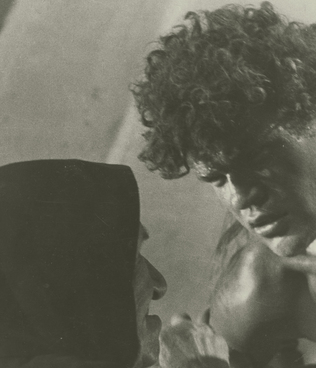On the door of his bedroom, Sergei Eisenstein hung a wood engraving by British artist and sculptor Gertrude Hermes (1901–1983), one of the first women to master the art of wood engraving in the 1930s when this was considered a purely men’s craft. During the war, she worked in Montreal and New York. The Warrior’s Tomb was her only major work of this period. After the war was over, she returned to London. There she became famous and was elected a member of the Royal Academy of Arts.
Gertrude Hermes' parents moved to England from Germany back in the 19th century, and although Gertrude Hermes was born in London and felt like an English woman, she still deeply felt for the tragedies of the German people who fell under the influence of Nazism, which caused millions of deaths worldwide, including Germany itself.
The plot for The Warrior’s Tomb was inspired by a newspaper article about the wreckage of a German submarine that was bombed by a British fighter plane in the Atlantic Ocean. Yet, the engraving is anything but a news report image of the event. The viewer sees only a shadow of the plane on the water, two gulls, and a giant whirlpool in the ocean—the trace of the explosion that took place in the depths of the ocean. Gertrude Hermes put the image in a circle and inscribed it around with a phrase, which she supposedly took from reports on the enemy bombing: ‘All that remained to be seen were bubbles rising and oil spreading over the surface of the sea’. ‘The Warrior’s Tomb’. Gertrude Hermes — 1941. 22/30’ This is the 22nd of 30 prints.
The composition of the engraving is a multi-dimensional metaphor. The circle represents the Earth covered by the war. The whirlpool and the blurring oil stain resemble the protoplasm of a crumbling cell, and the artist often used organic forms.
Experts do not know how Sergey got the engraving. Perhaps it was sent or brought to him by an American cultural figure at the end of the war or in the first years after it ended.
Gertrude Hermes' parents moved to England from Germany back in the 19th century, and although Gertrude Hermes was born in London and felt like an English woman, she still deeply felt for the tragedies of the German people who fell under the influence of Nazism, which caused millions of deaths worldwide, including Germany itself.
The plot for The Warrior’s Tomb was inspired by a newspaper article about the wreckage of a German submarine that was bombed by a British fighter plane in the Atlantic Ocean. Yet, the engraving is anything but a news report image of the event. The viewer sees only a shadow of the plane on the water, two gulls, and a giant whirlpool in the ocean—the trace of the explosion that took place in the depths of the ocean. Gertrude Hermes put the image in a circle and inscribed it around with a phrase, which she supposedly took from reports on the enemy bombing: ‘All that remained to be seen were bubbles rising and oil spreading over the surface of the sea’. ‘The Warrior’s Tomb’. Gertrude Hermes — 1941. 22/30’ This is the 22nd of 30 prints.
The composition of the engraving is a multi-dimensional metaphor. The circle represents the Earth covered by the war. The whirlpool and the blurring oil stain resemble the protoplasm of a crumbling cell, and the artist often used organic forms.
Experts do not know how Sergey got the engraving. Perhaps it was sent or brought to him by an American cultural figure at the end of the war or in the first years after it ended.



